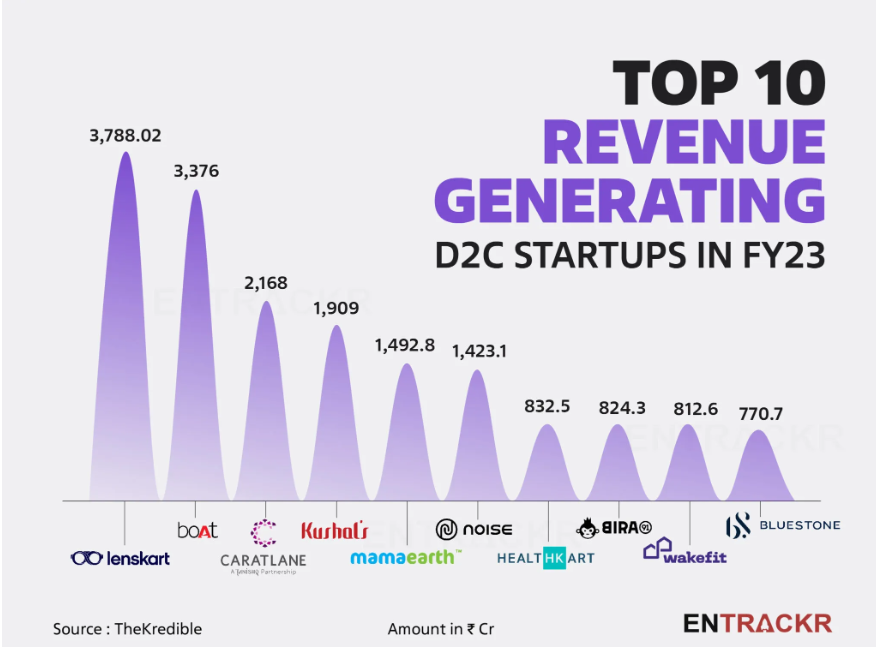
Published: Apr 23,2025

In the evolving landscape of Indian retail, Direct-to-Consumer (D2C) brands are reshaping how products reach consumers. By bypassing traditional intermediaries like distributors and retail stores, these brands sell directly to customers, primarily through their own websites and digital platforms. This approach not only offers greater control over branding and customer experience but also allows for more personalized marketing strategies.
In recent years, the adoption of Direct-to-Consumer (D2C) models in India has shown significant promise, indicating a bullish outlook for sectors such as Fast-Moving Consumer Goods (FMCG), fashion, home decor, and consumer electronics.
The Rise of Pure-Play Digital D2C Brands
Many emerging D2C brands in India adopt a pure-play digital model, relying exclusively on owned digital channels for marketing and sales. This includes utilizing websites, mobile applications, and social media platforms to engage with consumers. By analyzing customer purchase behavior and trends, these brands implement various customer engagement strategies to stay relevant and responsive.
Operating in a pure-play digital model offers brands full control over their business operations and sales processes. However, scaling can be challenging due to factors like market saturation and logistical constraints. Consequently, only smaller D2C players often sustain this approach.
Transitioning to Omnichannel Retailing
As products gain traction in the digital space, successful D2C brands often transition to an omnichannel retailing strategy, integrating both physical and digital modes to enhance customer engagement. This approach allows brands to provide a seamless shopping experience across various platforms, catering to a broader audience.
For Eg : one of the most famous D2C brand in India, Mamaearth is now available through almost 1.7 lac retail outlets across the country.
Millet-based snack brand Slurrp Farm, cosmetics makers Just Herbs and Sugar Cosmetics, lingerie brand Zivame, eyewear retailer Lenskart, wearables brand boAt, and beauty retailer Nykaa are among those which have opened physical stores.
Why Are D2C Brands Popular?
Establishing a Direct-to-Consumer (D2C) brand in India is a complex endeavor that presents numerous challenges. Entrepreneurs often encounter obstacles such as intense market competition, the necessity for substantial financial investment, and the imperative to develop a robust supply chain. Profitability in this sector is not easily achieved; reports indicate that only 12% of D2C brands in India have reached profitable operations. Consequently, building a successful D2C brand requires a long-term commitment, patience, and significant financial resources.
If you want to make it in to that 12% team who have moved to profitable business, you need to have a perfect system to synchronise the following phases in D2C business
Many reports suggest that, as of 2024, India is home to 800 or more direct-to-consumer brands with estimated market size of over 80 billion U.S. dollars, and many of them are already beating the normal FMCG brand by 1000s of crores. Lets check the top10 revenue generating D2C startups as on 2023.

Establishing a Direct-to-Consumer (D2C) brand in India presents both significant opportunities and formidable challenges. While the D2C market is poised for substantial growth, entrepreneurs must navigate obstacles such as intense competition, supply chain complexities, and the need for effective customer engagement strategies. Success in this sector demands a long-term commitment, patience, and substantial financial resources.
By understanding consumer behavior, optimizing logistics, and implementing effective growth strategies, brands can position themselves for success in a rapidly evolving marketplace. Focusing on customer retention through personalized experiences and engagement will further strengthen brand loyalty and foster long-term relationships. As the D2C landscape continues to evolve, brands that embrace innovation and adaptability will not only survive but thrive, ultimately reshaping the future of retail in India.
Check out the top D2C brands in India in our next blog.

Download the D2C Bank Account Freeze Survival Checklist (Free PDF) and get practical steps to protect your bank account freezes caused by fraudulent transactions.
Thank You! Your Freeze Survival Checklist is on its way
While you're here, don't stop at prevention - learn how leading D2C brands are using LYTTY to :
Or